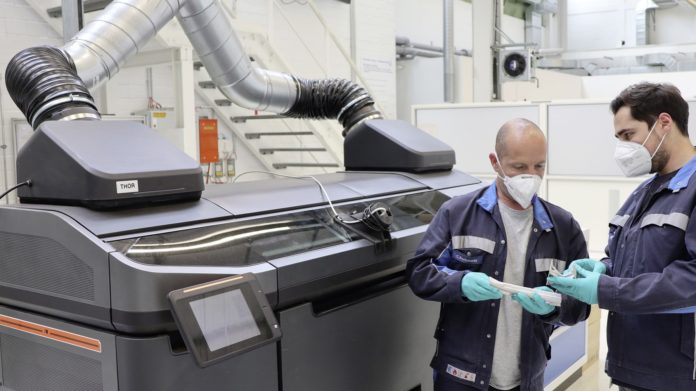
The first components made using the binder jetting process have gone to Osnabrück for certification: components for the A pillar of the T-Roc convertible
Until now, powder-bed technology has been the metal AM process of choice for car manufacturer Volkswagen. With the increasing maturity of technologies on the market, the car manufacturer plans to add another process to its vehicles production: binder jetting.
As a reminder, binder jetting is not about using a laser to build a component layer by layer but rather an adhesive.
To achieve this advance, Volkswagen has invested an amount in the mid-double-digit million euro range over the past five years.
Furthermore, from a technological perspective, the company is supported by Siemens at the software level. Indeed, thanks to Siemens’ software, VW is optimizing the positioning of components in the build chamber. Known as nesting, this technique makes it possible to produce twice as many parts per print session.
Cedrik Neike, member of the Managing Board of Siemens AG and CEO Digital Industries: “We are very proud to support Volkswagen with our innovative 3D printing solutions. Our automation and software solutions are leading in industrial production applications. Using this technology, Volkswagen will be able to develop and produce components faster, more flexibly and using fewer resources.”
VW has also deepened its existing collaboration with 3D printer manufacturer HP Inc whowill provide the new manufacturing equipment.
With the first full-scale use of binder jetting, the HP and VW teams intend to acquire important experience and learn, for example, which components can be produced economically and quickly in the future or how additive manufacturing can support the digital transformation of production at Volkswagen.
“Despite the ongoing challenges of the coronavirus pandemic, we’re continuing to work on innovation,” says Christian Vollmer, member of the Board of Management of the Volkswagen Brand responsible for Production and Logistics. “Together with our partners, we aim to make 3D printing even more efficient in the years ahead and suitable for production-line use.”
From summer, the three companies intend to establish a joint expert team at the high-tech 3D printing center which opened in Wolfsburg at the end of 2018 and enables the manufacture of complex automotive components using 3D printing. The center also trains employees in the use of these technologies.
By 2025, the aim is to produce up to 100,000 components by 3D printing in its main plant in Wolfsburg, Germany each year. The first components made using the binder jetting process have gone to Osnabrück for certification: components for the A pillar of the T-Roc convertible. These weigh almost 50 percent less than conventional components made from sheet steel. This reduction alone makes the process especially interesting for automotive production applications.
Volkswagen has already successfully conducted crash tests on 3D-printed metallic vehicle components. Until now, the production of larger volumes was not cost-effective enough. However, the new technology and the collaboration will now make production-line use economically viable.
Remember, you can post free of charge job opportunities in the AM Industry on 3D ADEPT Media or look for a job via our job board. Make sure to follow us on our social networks and subscribe to our weekly newsletter : Facebook, Twitter, LinkedIn & Instagram ! If you want to be featured in the next issue of our digital magazine or if you hear a story that needs to be heard, make sure to send it to contact@3dadept.com





